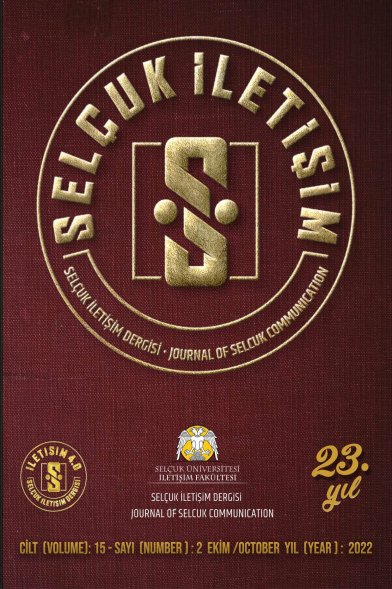Tüketicilerin internet reklamlarına yönelik tutumları
Consumers’ attitudes toward internet advertising
___
- Alwitt L F ve Prabhakar P R (1992) Functional And Belief Dimensions Of Attitudes To Television Advertising, Journal of Advertising Research, 32(5), 30–42.
- Anderson R D, Engledow J L ve Becker H (1978) Advertising AttitudesIn West Germany andThe U.S.: An Analysis Over Age And Ti- me,Journal of International Business Studies, 9, 27-38.
- Andrews J C (1989 The Dimensionality Of Beliefs Toward Advertising In General, Journal of Advertising, 18(1), 26–35.
- Bayram N (2004) Sosyal Bilimlerde SPSS İle Veri Analizi,Ezgi Kitapevi, Bursa.
- Berthon P, Pitt L F ve Watson R T (1996) TheWorld Wide Web As An Advertising Medium: Toward An Understanding Of Conversion Efficiency, Journal of Advertising Research, 43–54.
- Brackett L K ve CarrJr B N (2001) Cyberspace Advertising vs. Other Media: Consumer vs. Mature StudentSttitudes, Journal of Advertising Research, Eylül- Ekim, 23- 32.
- Cho C H ve Cheon H J (2004) WhyDo People AvoidAdvertising On The Internet?,Journal of Advertising, 33 (4), 89–97.
- DucoffeR H (1995) How Consumers Assess The Value Of Advertising Journal Of current Issues and Research in Advertising, 17 (1), 1- 18.
- Ducoffe R H (1996)Advertising Value And Advertising On The Web, Journal Of Advertising Research, Eylül – Ekim, 21-35.
- Erdoğan İ (2012) Pozitivist Metodoloji ve Ötesi, Erk Yayınları, Ankara.
- Gordon M E ve Lima-Turner K D (1997) Consumer Attitudes Towards Internet Advertising, International Marketing Review, 14 (5), 362-375.
- Hawkins D T (1994) Electronic Advertising: On Online Information Systems, http://web. ebscohost.com/ehost/detail?sid=99288288-48 89-45ae-aa515699ce0a4753%40sessionmgr10 4&vid=1&hid=126&bdata=JnNpdGU9ZWhvc 3QtbGl2ZQ%3d%3d#db=iih&AN=941102415 3, erişim tarihi 27.09.2011.
- http://www.milliyet.com.tr/turk-insani-haftada- 7-7-saati-sosyal-medyada-geciriyor/yasam/ hab erdetay/ 12.10.2010/1300304/default.htm (eri- şim tarihi: 18.07.2013)
- http://www.eweek.com/c/a/Search-Engines/ Yahoo-Refreshes-Upgrades-Some-Products- 775120/ (Erişim Tarihi: 18.07.2013)
- http://sosyalmedya.co/socialbakers-temmuz- turkiye-raporu/(Erişim Tarihi: 18.07.2013)
- İspir N B ve Suher K (2009) SMS Reklamları- na Yönelik Tüketici Tutumları, Selçuk İletişim Dergisi, 5(9), 5-17.
- Kalaycı Ş (2010) SPSS Uygulamalı Çok De- ğişkenli İstatistik Teknikleri, Asil Yayın Dağıtım, Ankara.
- Lutz R J (1985) Affectiveand Cognitive Antecedents of Attitude Towards The Ad: A Conceptual Framework, L F Alwitt ve A AMitchell (Der.),Psychological Processesand Advertising Effects Theory, Research, and Application, Lawrence ErlbaumAssociates, Hillsdale, NJ, 45-63.
- McMillan S J (2007) Internet Advertising: One Face Or Many?, D WSchumann ve E Thorson (Der.), Internet Advertising: Theory And Research,Lawrence Erlbaum Associates, Mahwah, N.J, 15-35.
- Mehta A ve Purvis S C (1995)When Attitudes Towards Advertising In General Influence Advertising Success,The Proceedings of the 1995 Conference of the American Academy of Advertising, Waco, TX: Baylor University, 190-196. Mehta A (2000) Advertising Attitudes And Advertising Effectiveness, Journal of Advertising Research, Mayıs – Haziran, 67-72.
- Micu A C (2007) Theoretical Approaches in Internet Advertising Research, D W Schumann ve E Thorson (Der.), Internet Advertising: Theory And Research, Lawrence ErlbaumAssociates, Mahwah, N.J, 37-68.
- Mittal B (1994)Public Assessment Of TV Advertising: Faint Praise And Harsh Criticism, Journal of Advertising Research, 35–53.
- Muehling D D (1987) An Investigation Of Factors Underlying Attitude Toward Advertising In General, Journal of Advertising, 16(1), 32–40.
- Pallant J (2007) SPSS Survival Manual, Open UniversityPress, New York.
- Pollay R W ve Mittal B (1993)Here's The Beef: Factors, Determinants, And Segments In Consumer Criticism Of Advertising, TheJournal of Marketing, 57 ( 3), 99-114.
- Previte J (1999) Internet Advertising: An Assessment Of Consumer Attitudes, Prometheus,17 (2), 199-209.
- Reid L N ve Soley L C (1982) Generalized And Personalized Attitudes Toward Advertising’s Social And EconomicEffects, Journal of Advertising, 11(3), 3–7.
- Sandage C H ve Leckenby J D (1980) Student Attitudes Toward Advertising: Institution vs. Instrument, Journal of Advertising, 9(2), 29– 32.
- Schlosser A E, Shavitt S ve Kanfer A (1999) Survey Of Internet Users’ Attitudes Toward Internet Advertising, Journal Of Interactive Marketing, 13 (3), 34-54.
- Severin W J ve Tankard J W Jr (2001) Communication Theories, Longman, New York.
- Shavitt S, Lowrey P M ve Haefner J E (1998, July/ August) Public Attitudes Toward Advertising: More Favorable Than You Might Think, Journal of AdvertisingResearch, 7–22.
- Wells W D ve Chen Q (2000)The Dimensions Of Commercial Cyberspace, Journal of Interactive Advertising, 1(1), http://jiad.org/ article4, erişim tarihi: 12.08.2011.
- Yang K C C (2003) Internet Users’ Attitudes Toward And Beliefs About Internet Advertising: An Exploratory Research From Taiwan, Journal of International Consumer Marketing, 15(4), 43-65.
- Zeff R L ve Aranson B (1997)Advertising On The Internet, J. Wiley, New York.
- Yayın Aralığı: 2
- Başlangıç: 1999
- Yayıncı: Selçuk Üniversitesi İletişim Fakültesi
DİYALOJİK İLETİŞİM ÇERÇEVESİNDEN ANKARA BÜYÜKŞEHİR BELEDİYESİ SOSYAL MEDYA UYGULAMALARI
YENİ TOPLUMSAL HAREKETLER VE SANAL GERÇEKLİK BOYUTUNDA GEZİ PARKI EYLEMLERİ
TOPLUMSAL CİNSİYET BAĞLAMINDA TÜRKİYE YAZILI BASININDA ŞİDDET HABERLERİ VE HABER FOTOĞRAFLARI
Reklamlarda gençlik kimliğinin kurgulanması: “Genç turkcell” örneği
Diyalojik iletişim çerçevesinden ankara büyükşehir belediyesi sosyal medya uygulamaları
KÜLTÜRLERARASI İLETİŞİM: KABHİ KHUSHİ KABHİE GHAM ADLI HİNT FİLMİNDEKİ KÜLTÜREL KODLARIN İNCELENMESİ
Yavuz Turgul sinemasında toplumsal değişim ve kriz anlatısı
REKLAMLARDA GENÇLİK KİMLİĞİNİN KURGULANMASI: “GENÇ TURKCELL” ÖRNEĞİ
Toplumsal cinsiyet bağlamında türkiye yazılı basınında şiddet haberleri ve haber fotoğrafları
